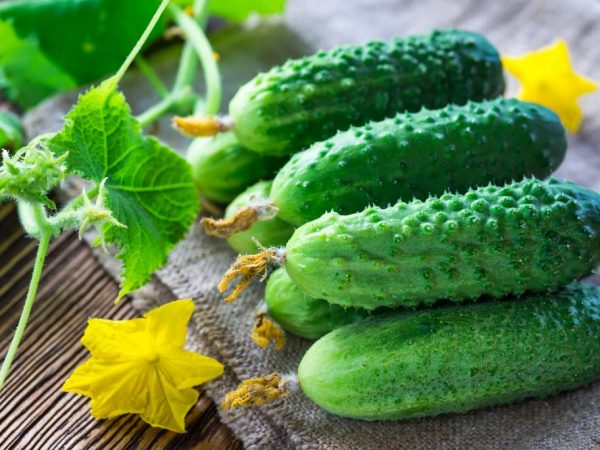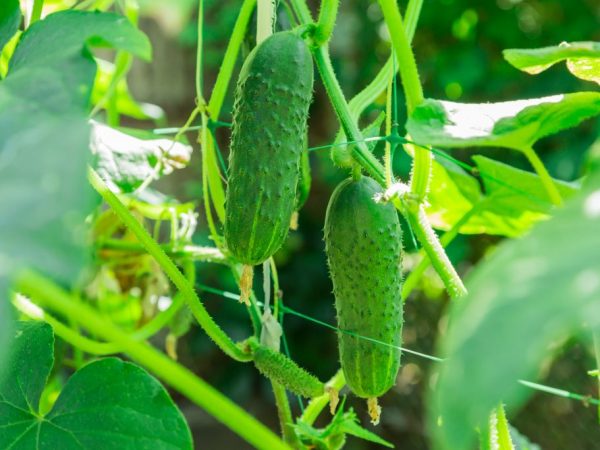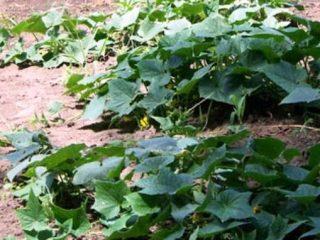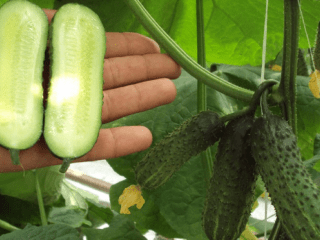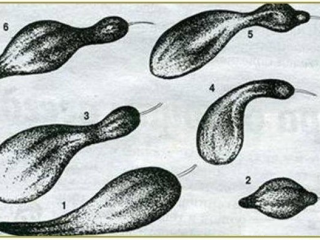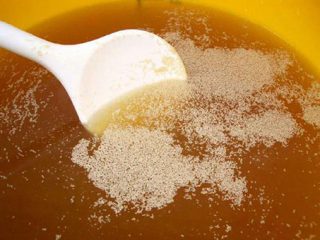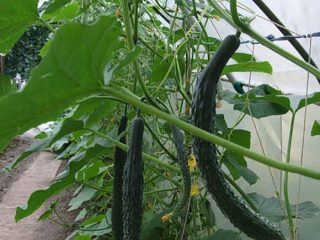Content
The Ekol cucumber is a relatively young hybrid form recommended for cultivation in the North Caucasus region. The variety is intended for planting both in open ground and in greenhouses.
Detailed description of the variety
The Ekol cucumber is a medium-sized hybrid that forms a compact shrub with short internodes. Plant growth is unlimited, since the variety belongs to indeterminate hybrid forms. The height of the bushes varies from 2 to 2.5 m. In greenhouse conditions, cucumbers can grow up to 3 m in height.
The leaves of the Ekol variety are dark green, small. The flowering of the hybrid occurs according to the female type - female flowers prevail over male ones. Each node produces 3 to 5 cucumbers.
A feature of the development of the Ekol variety is its upward orientation - the shoots are braided vertically and practically do not grow to the sides.
Description of fruits
The Ekol cucumber sets cylindrical fruits. Their length varies from 5 to 10 cm, the average weight is 90-95 g. Reviews note that the surface of Ekol cucumbers is bumpy, and the skin is covered with many small white thorns, as can be seen in the photo, for example.
The peel of the fruit is dark green in color. The flesh of the cucumbers is tender, crispy. There are no voids and no bitterness in it. The taste of the fruit is described as moderately sweet, the fruit is not bitter.
The field of application of Ekol cucumbers is universal. They are mainly grown for fresh consumption, however, in the same way they are commonly used for salting and preservation. Small fruits and dense structure of the pulp have won many positive reviews from those summer residents who used cucumbers for pickling.
Characteristics of Ekol cucumbers
In the State Register of the Russian Federation, Ekol cucumbers are indicated as a form suitable for growing in open ground and greenhouses. The key characteristic of the variety is its resistance to many diseases. In particular, plantings rarely get sick with powdery mildew, brown spot (cladosporia) and cucumber mosaic virus.
The frost resistance of the Ekol variety is average. During periods of prolonged drought, the fruits do not fall off the shoots, as is the case with most other species. The bushes bear fruit well both in the sun and in the shade.
Yield
Fruiting of cucumbers of the Ekol F1 variety occurs on average 40-45 days after the appearance of the first shoots. A feature of fruit setting is that the bushes do not need pollination - the hybrid is classified as a parthenocarpic type of cucumber.
The yield of the variety is 7-9 kg of fruits per bush. Fruiting can be stimulated by timely blinding of the lower nodes on the shoots. For this, the axillary ovaries are removed, which contributes to the development of the root system of the plant and an increase in the total number of fruits.
Pest and disease resistance
According to gardeners' reviews, Ekol F1 cucumbers have excellent immunity. They are resistant to many diseases that are typical for cucumbers, however, there are a number of diseases that can pose some danger to planting, namely:
- downy mildew;
- tobacco mosaic virus;
- white rot.
The main cause of infection is stagnant water as a result of over-irrigation and ignorance of crop rotation rules. Prevention of these diseases comes down to spraying the beds in advance with a solution of Bordeaux liquid and copper sulfate. Also, good results are shown by treating plants with mullein solution. In order to prevent the disease from spreading to neighboring bushes, the affected areas of the cucumbers are removed.
Insects infest the Ekol F1 cucumbers infrequently, however, this does not mean that preventive measures can be neglected. The following pests pose the greatest threat to the hybrid:
- whitefly;
- melon aphid;
- spider mite.
Planting against whitefly is sprayed with soapy water. As a preventive measure against the invasion of this pest, it is recommended to fertilize cucumbers with manure. Sticky traps have also worked well against whitefly.
Spraying with pepper infusion helps from spider mites. Melon aphids are scared away by the "Karbofos" solution.
Pros and cons of the variety
The positive characteristics of Ekol cucumbers include the following qualities:
- consistently high yield rates;
- resistance to many diseases;
- attractive appearance of the fruit;
- drought resistance - fruits do not fall off for a long time even with a lack of moisture;
- shade tolerance;
- the ability to collect part of the crop in the form of pickles;
- the possibility of long-term storage without losing the presentation and quality of the fruit;
- good taste - cucumbers are not bitter.
The disadvantages include, first of all, the fact that the planting material for Ekol F1 cucumbers cannot be prepared independently. The fact is that this is a hybrid form, which means that the seeds will have to be bought in the store every year.
Also in the reviews, the disadvantages include the prickly fruit, which makes it difficult to harvest, and the vulnerability to downy mildew. In addition, if the crop is not harvested on time, cucumbers begin to barrel.
Growing rules
Ekol F1 cucumbers can be grown using both sowing and seedling methods. When planting in open ground, it is necessary to take into account the peculiarities of crop rotation - cucumbers develop best in areas where legumes, potatoes, bell peppers and onions grew before.
Growing in a greenhouse requires regular ventilation. Otherwise, air humidity reaches a critical level, which contributes to the development of fungal infections.
Sowing dates
Using the sowing method, Ekol F1 cucumbers are planted in open ground or a greenhouse in mid-May, when the soil temperature reaches at least + 15 ° C.
Planting with a seedless method is carried out in mid-May, when the soil is completely warmed up. For seedlings, cucumbers are sown in late March - early April.
Site selection and preparation of beds
The place for planting Ekol F1 cucumbers is chosen taking into account the following recommendations:
- Cucumbers bear fruit best on medium loamy, loose soils with good air circulation.
- The Ekol F1 variety belongs to heat-loving plants. Despite the fact that the hybrid is quite shade-resistant, it demonstrates its best qualities when grown in sunny areas.
- Landings should be well protected from strong wind gusts. The variety is very tall, so the stems can break under the influence of frequent drafts.
Preparation of soil for planting cucumbers begins in advance - in the fall. It includes the following steps:
- First of all, you need to remove all debris from the site. From future beds, the tops left after previous crops are harvested, weeded weeds.
- It is recommended to remove the topsoil before planting in the greenhouse. This is done in order to protect cucumbers from pest larvae and fungal spores.
- After that, the soil is dug onto the bayonet of the shovel.The procedure is combined with the introduction of organic fertilizers, which will not only serve as a source of nutrition for the cucumbers, but also contribute to an increase in soil temperature. Horse manure is best suited for these purposes, which, moreover, kills harmful bacteria.
- Heavy soils can be corrected by adding wet sawdust.
How to plant correctly
Planting of cucumbers of the Ekol F1 variety for seedlings is carried out as follows:
- Seedlings are grown in individual containers, the volume of which is 0.5 liters. In common containers, Ekol F1 cucumbers are not sown - picking for this variety is stressful.
- The seedling soil mixture can be purchased at any gardening store or you can make it yourself. For this, fertile soil, sawdust, humus and peat are mixed in equal quantities.
- Before sowing seeds, it is advisable to soak them in a solution with the addition of a growth stimulator (Kornevin, Zircon).
- Before sowing seeds, the soil is disinfected with a weak solution of manganese.
- The seeds are deepened by no more than 3 cm. Thus, the seedlings will quickly form a full-fledged root system and break through the thickness of the earth.
- Immediately after planting the seeds, the containers are covered with glass or plastic wrap to create a humid microclimate. As soon as the first shoots appear, the shelter is removed. One month after that, the seedlings can be moved to a permanent place in the open ground or greenhouse.
- Seedlings are watered abundantly, but rarely. Use only warm water for this.
- The seedlings are fed with complex fertilizers.
When planting in open ground, cucumber seeds are sown at a distance of 30 cm from each other. The recommended row spacing is 65 cm.
You can learn more about the features of growing Ekol F1 cucumbers from the video below:
Follow-up care for cucumbers
It is not difficult to take care of the plantings of Ekol F1 cucumbers. The main thing is to adhere to some recommendations:
- The bushes are watered with exceptionally warm water. In no case should the plantings be poured. In addition, it is advisable to water in small grooves dug around the plants, since the introduction of moisture directly under the stem can damage the root system of the bush.
- Shoots, the length of which does not reach the trellis by 25-30 cm, must be removed.
- Cucumbers are fed with organic solutions. In dry form, organic matter is not recommended to be introduced into the soil. The Ekol F1 variety responds especially well to fertilization with a solution of wood ash.
- For better development of cucumbers, it is recommended to periodically loosen the soil under them. This procedure improves air circulation in the soil, saturating the plant root system with oxygen. In addition, loosening the soil prevents moisture stagnation.
Conclusion
The Ekol cucumber, despite its youth, has already managed to win noble reviews from gardeners. The popularity of this hybrid form is explained by the consistently high yield rates, excellent immunity of the variety, the absence of bitterness in cucumbers and the versatility of the fruit. Also, cucumbers of the Ekol F1 variety are quite unpretentious, so even beginners can grow them.
